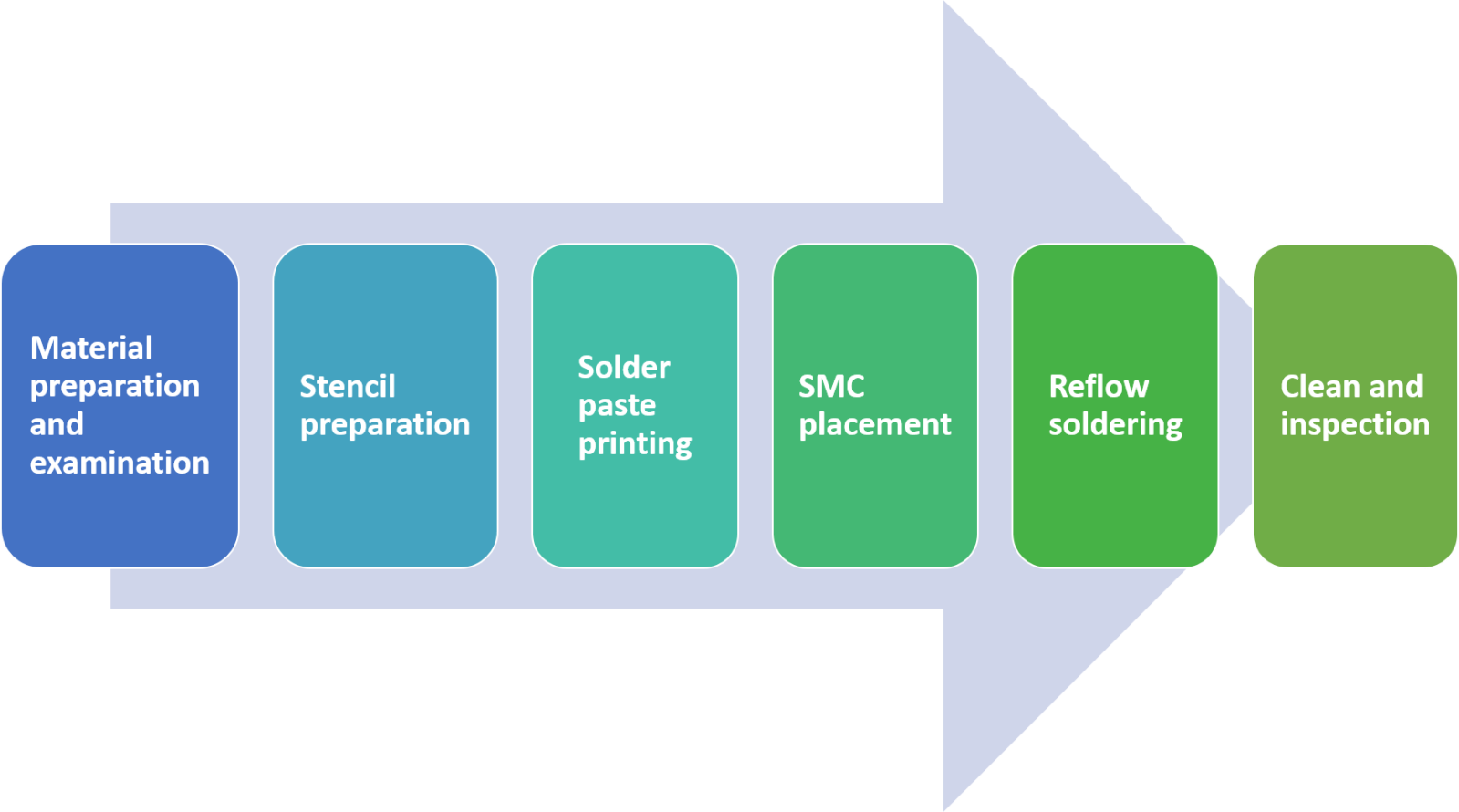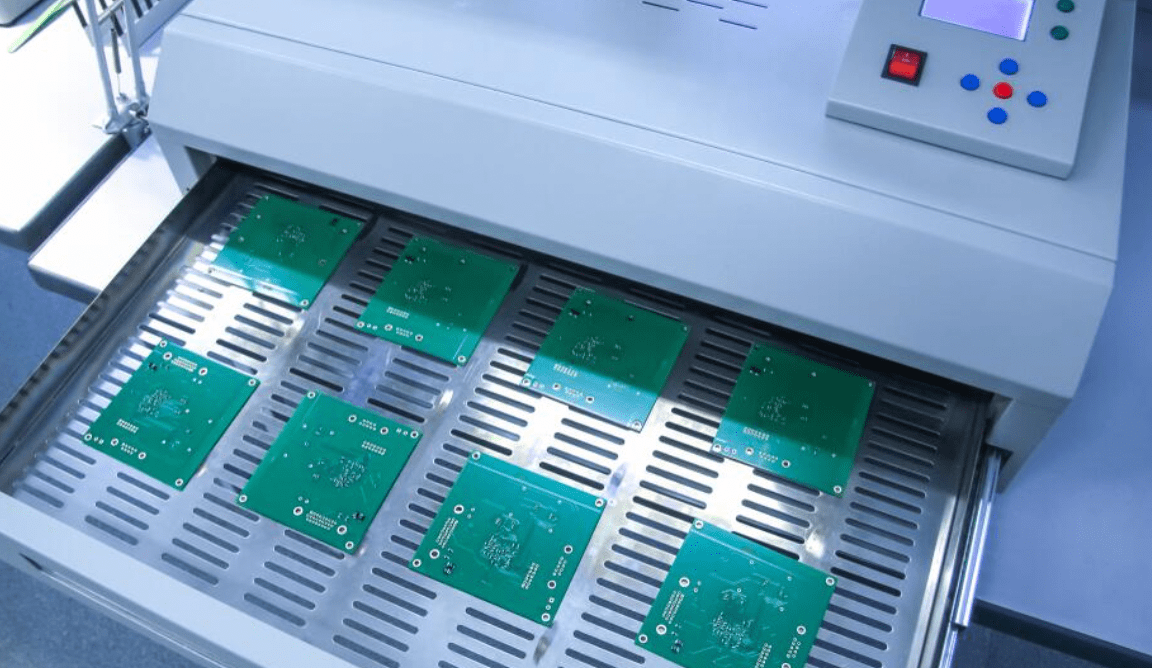Surface mount technology (SMT) is an aspect of electronics assembly in which electronic components, also known as surface mount devices (SMD), are mounted directly to the surface of a printed circuit board (PCB). SMT is highly sought after in the industry due to its cost and quality efficiency. In the SMT production line process, components are directly welded to the surface of the PCB, and the precise positioning and installation of the components are completed through equipment such as placement machines.
Surface Mount Technology (SMT) stands as a cutting-edge assembly and production method, directly placing electronic components onto a printed circuit board (PCB). This advanced process streamlines automated production, efficiently completing the necessary assembly for a functional board. Any electrical component attached this way earns the title of a Surface-Mount Device (SMD). In contrast to traditional assembly, SMT skips the component-insertion step through holes; instead, components get soldered onto the board directly via reflow soldering.
IBM, in the 1960s, initially named this groundbreaking approach Planar Mounting. They applied it to construct small-scale computers, supplanting the previous Through-Hole Technology. Despite its inception, SMT didn't gain widespread use until 1986 when surface-mounted components achieved a 10% market share. Fast forward to 1990, and surface-mounted devices (SMDs) dominated the majority of high-tech printed circuit assemblies. This marked a significant shift in the landscape of electronics manufacturing. These days, SMT is used in almost every electronic device ranging from toys to kitchen appliances, to laptops and smartphones.
Due to the precision required to create high-quality surface mount assemblies (SMAs), the SMT assembly process can be tedious and time-consuming if done manually. Therefore, to improve efficiency, most SMT manufacturing is done through automated assembly machines, especially when producing in large quantities. Let us understand the smt production process
SMT manufacturing process comprises three key stages: solder paste printing, components placement, and reflow soldering. This structured approach ensures precision and efficiency in assembling electronic components directly onto printed circuit boards.

(SMT Process FLow Chart)
In this phase, a printer applies solder paste to a printed circuit board (PCB) using a pre-made stencil and squeegees. The solder paste, comprising flux and tin, facilitates the connection between Surface Mount Components (SMCs) and solder pads on the PCB.
Achieving precise paste coverage on each pad is crucial during this process. Inaccuracies may impede the establishment of connections when the solder undergoes melting in the subsequent reflow oven stage.
Maintaining quality control in solder paste printing is paramount. Any defects detected during this stage can cascade into more significant issues downstream. The design of the stencil is critical, requiring the assembly team to ensure a repeatable and stable process. While many solder paste printers incorporate automatic inspection features, some utilize external machines with 3D technology for a more thorough assessment. These external inspection devices evaluate factors like solder paste volume per pad, providing a comprehensive analysis beyond the simple assessment of the print area.
After passing inspection, the PCB progresses to the component placement stage in the SMT assembly process.
Each component destined for the PCB is taken out of its packaging using either a vacuum or a gripper nozzle. Then pick-and-place machines precisely position individual electronic components onto the solder paste applied earlier on the printed circuit board (PCB). These machines not only boast high accuracy but also operate at remarkable speed. Top-tier machines can place up to 80,000 individual components every hour, showcasing the efficiency of this advanced assembly process.
Accuracy is required in this process because any erroneous placement soldered into a position can be costly and time-consuming to rework.

Reflow Soldering is a crucial stage in the assembly of printed circuit boards after placing Surface Mount Components (SMCs). The PCB is conveyed into a reflow soldering oven, undergoing a carefully orchestrated soldering process in distinct temperature-controlled zones:
Preheat Zone: The initial zone gradually raises the temperature of the entire PCB and its attached components simultaneously. The temperature increases at a controlled rate (1.0℃-2.0℃ per second) until reaching a range of 140℃-160℃.
Soak Zone: In this phase, the board is maintained at a steady temperature between 140℃ and 160℃ for a duration of 60-90 seconds.
Reflow Zone: The PCB then enters a zone where the temperature is ramped up (1.0℃-2.0℃ per second) to a maximum of 210℃-230℃. This elevated temperature melts the tin in the solder paste, effectively welding the component leads to the pads on the PCB. Throughout this process, the components remain in place due to the surface tension of the molten solder.
Cooling Zone: The final section ensures the solder solidifies upon exiting the heating zone, preventing joint defects.
After reflow soldering, final inspection is performed using a 3D automated optical inspection machine (AOI). This ensures expected solder joint quality and identifies any errors in the SMT process. Using machines at this stage can increase efficiency and accuracy compared to manual inspections.
In cases of double-sided PCBs, these soldering processes may be repeated. This involves the use of either solder paste or glue to secure the SMCs in place. This meticulous approach to reflow soldering guarantees the integrity and functionality of soldered connections in electronic assemblies.
A Surface Mount Technology (SMT) production line involves several key pieces of equipment that work in concert to assemble electronic components on printed circuit boards. The main equipment in an SMT line includes:
Stencil Printer: The stencil printer applies solder paste to the PCB using a stencil, ensuring precise placement of the paste on designated areas.
Pick-and-Place Machine: This automated machine picks up electronic components and accurately places them onto the PCB according to the design specifications. It handles various types and sizes of components.
Reflow Soldering Oven: The reflow soldering oven is where the PCB, with its components and solder paste, goes through controlled heating and cooling processes. This melts the solder, creating secure electrical connections.
Solder Paste Inspection (SPI) Machine: SPI machines inspect and verify the accurate deposition of solder paste on the PCB before component placement, ensuring the quality of the soldering process.
Automated Optical Inspection (AOI) Machine: AOI machines inspect the PCB after the soldering process to detect defects, misalignments, or soldering issues. They use cameras and image processing to perform detailed inspections.
Conveyor System: A conveyor system transports the PCBs through different stages of the SMT line, connecting various machines seamlessly.
Wave Soldering Machine (Optional): In some cases, especially for through-hole components, a wave soldering machine may be used as an alternative or in addition to reflow soldering.
Depaneling Machine: After assembly, the PCBs may be connected in a panel, and a depaneling machine is used to separate them into individual boards.
Screen Printer (Optional): In addition to stencil printing, some SMT lines may include a screen printer for specialized applications or certain types of components.
Conformal Coating Machine (Optional): For added protection, some SMT lines include a conformal coating machine that applies a thin protective layer to the PCB.
The layout of a Surface Mount Technology (SMT) production line is crucial for optimizing efficiency and throughput. There are several types of SMT line layouts, each designed to meet specific production requirements. Here are some common SMT line layout types:
In-line Layout: In an in-line layout, the SMT machines are arranged in a straight line, and the PCBs move sequentially from one machine to the next. This layout is simple, easy to understand, and suitable for smaller-scale production.
U-Shaped Layout: A U-shaped layout involves arranging the SMT machines in the shape of a "U," allowing for a continuous flow of PCBs. This layout is efficient for larger-scale production as it minimizes the distance the PCBs need to travel between machines.
L-Shaped Layout: In an L-shaped layout, the SMT machines are arranged in the shape of an "L." This layout is often used when space is limited, and it provides a compact design while still allowing for a continuous flow of PCBs.
Cellular Manufacturing Layout: Cellular manufacturing involves grouping related machines and processes into cells. Each cell is dedicated to a specific task, such as solder paste printing or component placement. This layout enhances flexibility and efficiency.
T-Shaped Layout: A T-shaped layout involves arranging the machines in the shape of a "T." This layout is versatile and can accommodate various production volumes while maintaining a smooth flow of PCBs.
Multi-Line Layout: In a multi-line layout, multiple production lines run parallel to each other. This design is suitable for high-volume production, allowing for simultaneous processing of multiple PCBs.
Learn more about SMT line layout
A Surface Mount Technology (SMT) engineer, also known as an SMT process engineer or manufacturing engineer, is a professional responsible for overseeing and optimizing the processes involved in the assembly of electronic components on printed circuit boards (PCBs) using surface mount technology. This engineer assists in the placement of electronic materials on PCBs, defines and upgrades the SMT assembly processes, implements and verifies special manufacturing procedures.
At VictoryPCB, we value experience as the ultimate teacher. Our team comprises seasoned SMT process engineers, bringing a wealth of practical knowledge to the table. We understand the importance of a balanced blend of skills, education, and hands-on experience, ensuring that our SMT engineers are well-equipped to meet the demands of cutting-edge electronics manufacturing.
Experience the pinnacle of PCB assembly precision with VictoryPCB. Our state-of-the-art SMT production line in Shenzhen, China, is ready to bring your electronic designs to life. Trust in our expertise, cutting-edge technology, and unwavering commitment to quality. Contact us today to embark on a journey of innovation and seamless PCB assembly. Your success starts with VictoryPCB.
By continuing to use the site you agree to our privacy policy Terms and Conditions.
Recruit global agents and distributors Join us